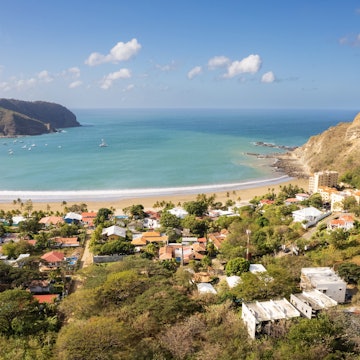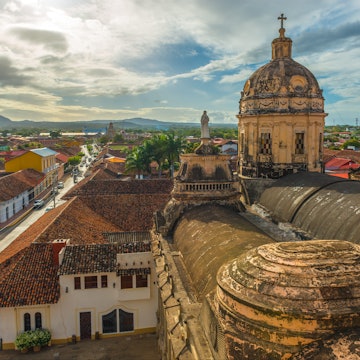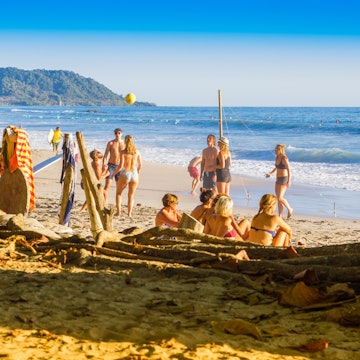

Little Corn Island, Nicaragua. Michael George for Lonely Planet
Nicaragua is an easy place to fall in love with, and first-time visitors are often surprised by what they find: colorful old streets; horses pulling wagons down the highway; volcanoes rising confidently over forest and farm; strangers eager to give directions and have conversations. Nicas are famously gentle and chatty.
Despite natural disaster and other struggles this nation has endured, Nicaragua has cultivated a rich tourism circuit, inviting travelers to enjoy tropical weather, boundless natural wonders and cities that look like they're straight out of a movie set.
Here are the top things to do in Nicaragua.

1. Explore history in Managua
Forming a crescent around Lago Xolotlán, Managua – Nicaragua’s capital – makes a dizzying impression on first-time visitors. International flights touch down at Managua International Airport on the eastern edge of this amorphous metropolis.
Once you settle in, visit the Palacio de la Cultura y Biblioteca Nacional (Palace of Culture and National Library), which has witnessed history numerous times since its completion in 1935. Until 1994, Nicaragua’s congress convened here; in 1972, an earthquake shook its walls but somehow left it unscathed, even as the surrounding neighborhood crumbled to dust; in 1978, it became a flashpoint when guerrilla rebels commandeered the building and took officials hostage, marking a turning point in the Nicaraguan Revolution and increasing global interest in the Sandinistas. Today, the Palacio is a voluminous museum, with gorgeous courtyards, vast exhibition spaces and curated displays ranging from Nicaragua’s volcanic formation to indigenous pottery.
Also worth a visit is the Catedral de Santiago (St James Cathedral), a masterwork of pillars and domed towers, with surrounding palm trees accentuating its tropical aesthetic. You might believe that these weathered stone walls were first erected by conquistadors some centuries ago, but the cathedral is actually much newer: Belgian architect Pablo Dambach designed and oversaw the completion of this neoclassical beauty in 1938.
Today, it’s one of the few vestiges of Old Managua; the church survived the earthquake of 1972, but damage to the interior has left it off-limits to visitors. Still, the cathedral is a stirring monument from the outside, and visitors can try to peek through its openings and take pictures out front. The main entrance stands to one side of the Plaza de la Revolución, making it as central as Managua gets.
Detour: A second cathedral, the Catedral Metropolitana (Metropolitan Cathedral), stands about 3.4km south, off of a busy highway right across from the Estadio Nacional Soberanía. The Metropolitana is Santiago’s opposite in appearance: more bunker than church, the walls are modernist concrete with a single tower, and the 63 white domes on its roof have earned a lot of dirty jokes since it opened in 1993. The cathedral holds regular services and events; inside is a life-sized diorama of the crucifixion.
2. See ancient petroglyphs on Ometepe
Isla de Ometepe, located in the middle of Lago Cocibolca, is a legend among backpackers in Central America who yearn for a secluded getaway. The island is formed out of not one but two volcanoes that have melded into a single, barbell-shaped land mass. For well over 3000 years, the indigenous people of Ometepe lived, fished and chiseled rocks. They were prolific in the latter: archaeologists have discovered 73 different petroglyph sites, with figures and patterns etched into 1400 boulders around the island.
Many of these petroglyphs seem to represent people and animals, while others are more abstract motifs, but all are rendered with deep, confident lines. The easiest way to see these pre-Columbian artifacts is to visit the Museos El Ceibo in the northwestern village of Sacramento.
Detour: The Cascada San Ramón (San Ramón Waterfall) is a veil of water that pours down a 40m wall of mossy rock. The upper echelons tower over visitors, who can only gaze up in wonder and splash in the small pool below. The traditional way to get to San Ramón is to walk. A car can take you to a parking lot well within the Reserva de Biosfera (Biosphere Reserve), about a 20-minute drive from the popular beach town of Mérida. From here, the trailhead is roughly a 40-minute hike from the falls, depending on conditions. Bring your toughest footwear, especially for the final scrambles.

3. Wander through the lively streets of Granada
Granada, the former capital of Nicaragua, is a well-preserved gallery of architecture from its time as a Spanish colony, and the colorful buildings and ornate entryways just beg to be photographed from every angle. The iconic Catedral de Nuestra Señora de la Asunción rises from its center, a masterpiece of bright yellow walls and red domes. On the horizon looms Volcán Mombacho, one of the most picturesque of Nicaragua’s many volcanoes, and the waterfront abuts the storied Lago Cocibolca.
Plenty of travelers have visited Nicaragua just to wander the lively streets of this beloved city, which recently celebrated its 500th anniversary, making it one of the oldest former European colonies in the Americas. History buffs will find a rich Catholic heritage and endless folklore to absorb, including the city’s tragic immolation at the hands of invading Filibusteros in 1856. Granada remains a very real city, with 134,000 permanent residents and a proud civic culture.
Planning tip: When night falls – and temperatures become more bearable – festive crowds converge on the Parque Central for outdoor dining and live music. One of the biggest events is La Purísima, a 9-day festival at the start of December that celebrates the Virgin Mary with food, music – and shouting.

4. Chill on the beach or surf the waves at San Juan del Sur
San Juan del Sur is Nicaragua’s showcase beach town, where a global cast of adventure-seekers congregate for cheap lodging, good eats and easy access to neighboring surf. The surrounding forested hills bear-hug the town and bay, isolating it from the broader countryside. Bars and restaurants press against a wide, dark beach, and boats of all kinds bob in the gentle swells. With a population of around 15,000, San Juan del Sur is a relaxed little town.
Planning tip: Locals will offer to sell you marijuana (and more) everywhere you go in San Juan del Sur. Cannabis in all forms is illegal in Nicaragua, and 20g could land you in prison for up to 3 years. Respond to drug offers with a polite no.

5. Dive in the Corn Islands
If your country has only one major Caribbean getaway, it might as well be perfect. The Corn Islands are two tiny land masses about 70km off the eastern coast of Nicaragua, and each has more than its share of palm trees, white-sand beaches and crystal blue waters. Officially known as Great Corn Island and Little Corn Island in both English and Spanish, the former (also known as Big Corn Island) is about 5km across and is home to most of the islands’ 7700 people, while the latter is a quiet cay with a handful of hotels and restaurants.
Waves of indigenous groups, buccaneers and enslaved people arrived on these shores, and many residents are of African heritage and speak an English-based Creole. Backpackers get weak-kneed over the isolation and spectacular diving, and more travelers are flying to Managua’s airport just to boomerang in this direction.
Planning tip: The community’s all-encompassing recreational hot spot is the Corn Island Dive Center, where you can try a first scuba-diving course (US$70) or earn a PADI certification (US$370). If you’d prefer to stay above water, the center also also rents kayaks, enabling paddlers to explore the coves and beaches around Great Corn Island, and the inland mangrove swamps.

6. Shop for local crafts in Masaya
Variously described as “the City of Flowers” and “the Cradle of Nicaraguan Folklore,” Masaya is best known among travelers as the top place to buy local handicrafts. This is no accident: the region is home to countless workshops, where artisans weave textiles, sculpt clay and carve wood. These craftspeople all meet in the teeming streets of Masaya, selling one-of-a-kind wares to tourists and residents. Standing only 16km from Granada, this is a straightforward community, with economic hotels and pleasant public parks.
Given the limited dining and nightlife, many are surprised to hear that this working-class enclave is home to about 140,000 people, making it the fourth-largest city in Nicaragua. Lodging in Masaya provides easy access to two of the nation’s natural wonders, Volcán Masaya and the Laguna Apoyo, as well as the Pueblos Blancos, where local artisans work their magic.
Planning tip: In September, Masaya celebrates the Fiesta de San Jerónimo, when visitors pour in for concerts and carnival shows.

7. Visit the house of Carlos Fonseca in Matagalpa
Nestled in a forested valley and surrounded by high hills, Matagalpa is the cultural capital of Nicaragua’s Northern Highlands. Once an indigenous settlement, the town takes pride in its rural heritage. The indigenous name is said to have meant “let’s go where the rocks are,” a reference to the rocky river that flows through the middle of town; it’s much better known as La Perla del Septentrión (the Pearl of the Northland).
Here, the Casa Museo Comandante Carlos Fonseca (House Museum of Commander Carlos Fonseca) tells the story of a revolutionary in the making. Raised by a working-class mother and estranged from his wealthy father, the guerrilla fighter grew up in a corner house in the El Laborio neighborhood of Matagalpa, about 1km south of the cathedral. The house is now a museum, where his biography is passionately chronicled in a series of Spanish language panels. A statue of the man, skinny and bespectacled, stands in the front room. One of the most moving artifacts is the typewriter on which Fonseca composed some of his most influential works. It was loaned by his comrade Dr Ramón Gutiérrez. A strong proponent of public access, Fonseca would have approved of the museum’s free admission.

8. Hike and sleep on a volcano
The Reserva Natural Telica-Rota is a cluster of volcanic mountains covering 90 sq km of protected land just northwest of León. Telica is the most famous of the reserve’s prominences, but they all get attention; these are the mountains city-dwellers see on the León horizon.
Volcán Telica rises 1036m above sea level, and if you stand – or better yet, crouch – on the edge of its voluminous crater, you may see the glowing magma within. The cliffs drop straight down, and sulfuric clouds rise ominously from its depths, making this one of the most dramatic sights in Nicaragua.
The most direct route to the summit of Telica is a moderate 45-minute hike through rocky lava fields and stunted shrubbery. The trailhead is a 90-minute drive from León, making this a favorite excursion for outdoor enthusiasts with a seismic streak. The rugged road across the park requires a 4WD vehicle, and most rental cars won’t make the grade.
Planning tip: Both Volcano Day and Bigfoot Hostel organize regular tours up here, including sunset hikes and overnight camping. For the camping tours, you’re generally expected to bring (and carry) your own tent, along with other basic equipment. The park’s admission is usually included in the tour price. Adventure-seekers can board down the slope with a tour.
9. Tour the childhood home of poet Rubén Darío in León
The famed Nicaraguan poet Rubén Darío spent the first 14 years of his life in a handsome house built in the Spanish architectural style in the middle of León, and residents eagerly claim him as their hometown hero.
This abode, with its many rooms and classic wooden ceilings, was transformed into the Museo Rubén Darío in 1964, and many fans of Spanish literature have made a pilgrimage here. Among the displays, you can see documents written in Darío’s elegant hand, as well as portraits of his extended family and – naturally – shelves full of books. His death mask, preserved under glass, is about as close as anyone will get to meeting the actual man, although his remains are interred in León’s Catedral, guarded by a sorrowful lion and the inscription “Nicaragua is created of vigor and glory, Nicaragua is made for freedom.”
The rooms are decorated with period furniture, along with artworks and artifacts; it’s easy to imagine the fledgling writer hanging around the leafy central court, contemplating his early stanzas. Alienated from his biological parents, the young Rubén was raised here by his aunt and uncle. In these chambers, he allegedly learned to read by the age of three.
Planning tip: The Museo Rubén Darío is open daily from 8am to noon and from 2pm to 5pm, but it’s closed Mondays.
This article was adapted from Lonely Planet’s Central America guidebook, published in October 2025.














